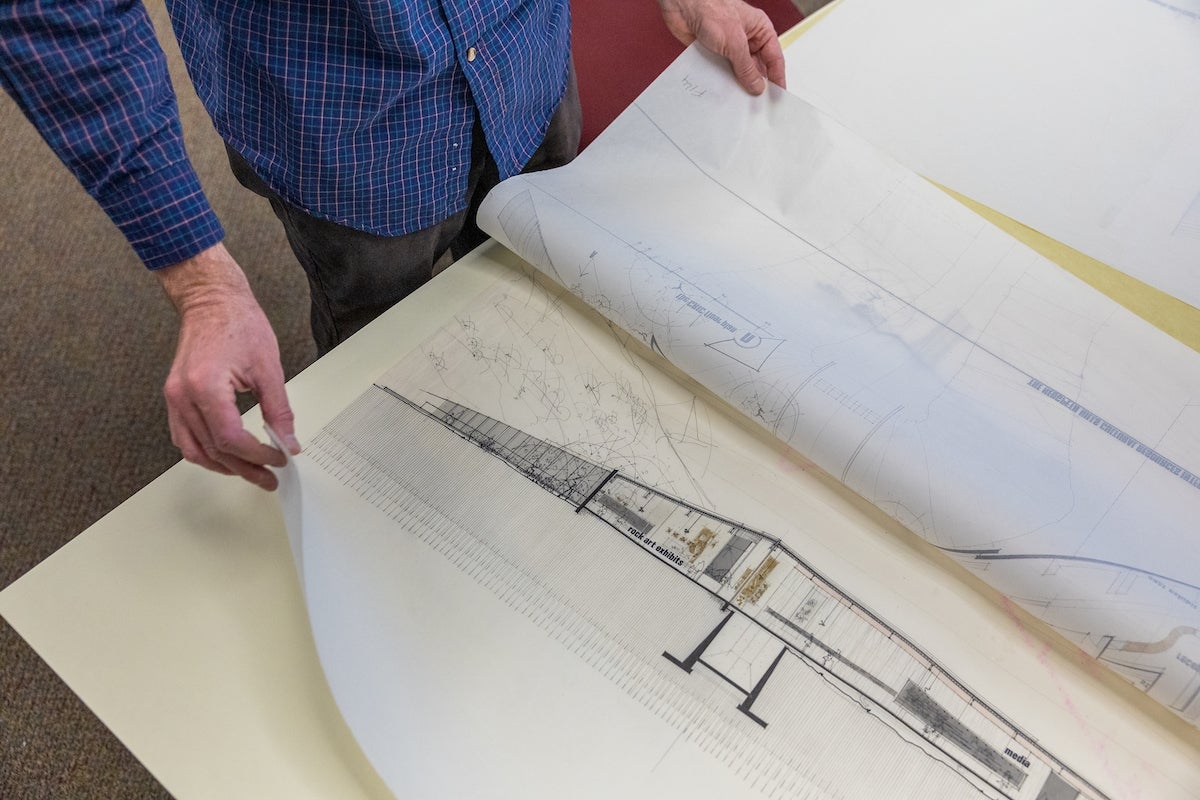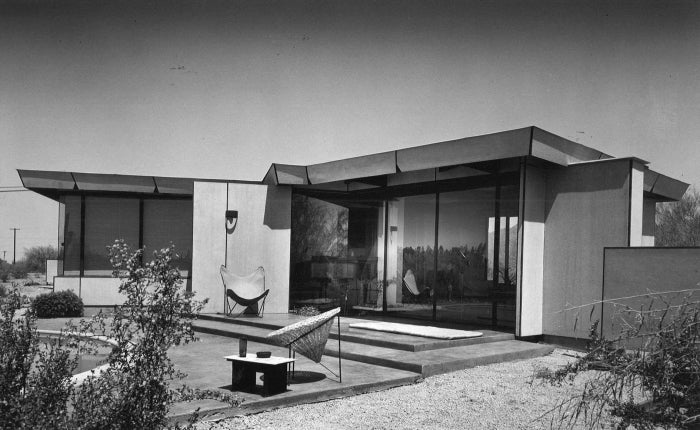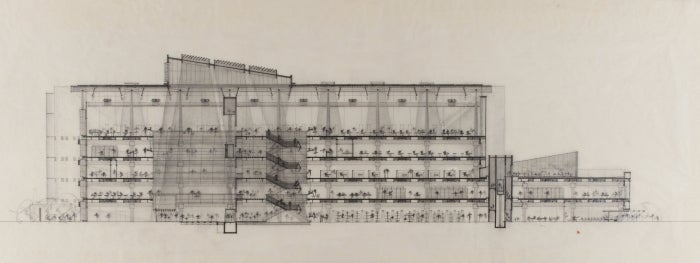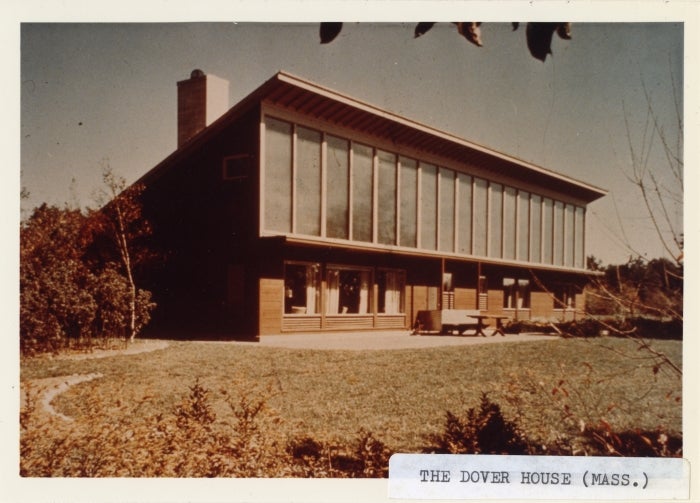ASU collection preserves legacy of modern architects, buildings in the Southwest

Archivist Harold Housley looks at items from ASU's Design and the Arts Special Collections, which houses the drawings, blueprints and ephemera related to different architects and prominent buildings in Arizona. Photo by Deanna Dent/ASU
Editor’s note: This story is part of a monthly series spotlighting special collections from ASU Library’s archives throughout 2024.
Arizona has a complicated record when it comes to the preservation of historic structures. It’s a place that thirsts for development, regularly churning the old back into the earth so that something new can grow in its stead. However, some architectural gems have managed to dodge the wrecking ball over the years; the Arizona Biltmore, Taliesin West, Cosanti and ASU Gammage are a handful that come to mind.
In addition, a rich archive of architectural drawings, presentation boards, monographs, serials and audiovisual materials relating to the design, development and evolution of modern architecture in the Southwest has also found safe harbor — in ASU Library's Design and the Arts Special Collections.
Visit the archive
For questions or to view materials regarding the Design and the Arts Special Collections, reach out to the ASU Library’s Ask an Archivist service.
The collection includes architecture-related items and original source materials from several innovators and leaders in architecture, design and desert modernism in Arizona and elsewhere in the country.
“This is a collection where a diverse but select group of innovative and groundbreaking Southwestern architects are represented,” said Harold Housley, archivist for the Design and the Arts Special Collections, where he is responsible for collection management and development, reference, outreach and instruction. “These were all people who were and are on the cutting edge in their field because they got a clean slate by coming to Arizona; a kind of freedom they didn’t feel in other areas of the country.”
Collection origins
According to Housley, an architecture library was established in 1960 at ASU as the first branch outside of the Tempe campus library. It was built to support the School of Architecture, which had begun offering a Bachelor of Arts in 1957. It later became the College of Architecture in 1964 and the College of Architecture and Environmental Design in 1983, to accurately reflect the depth and breadth of design and planning studies within its programs, such as interior design and landscape architecture. Since 2010, the program has been part of The Design School within ASU’s Herberger Institute for Design and the Arts.
Housley said the library initially collected books and periodicals but there was some interest by faculty members in the 1970s to establish a special collections component that would include rare books, architectural drawings and letters on the subject. One of the first efforts came about in 1972 when faculty member Jeffrey Cook received a grant to establish a Paolo Soleri archive at ASU that would document the Italian architect’s work. In the early 1980s, there was also an effort to establish a research collection on Frank Lloyd Wright that would include rare books as well as drawings.
As the archive matured and evolved and new building space became available in 1989, this allowed for expansion of the collection to include architectural drawings and files from prominent architects such as Blaine Drake, Albert Chase McArthur, Alfred Newman Beadle, Mária Telkes, Paolo Soleri and William P. Bruder, as well as a solar energy collection previously housed at Noble Library.
Today, there are 40 manuscript collections in the Design and the Arts Special Collections. It’s approximately 1,300 linear feet, and mainly features architectural drawings, along with photographs, correspondence, job files and other items of interest to budding designers, historians and writers.
Collection highlights
Blaine Drake (1911–1993)
While Wright is perhaps the most famous American architect to leave his indelible mark in Arizona, one of the men who blazed the trail for post-warOther prominent post-war modernism architects who arrived in the Phoenix area around the same time include Edward L. Varney, Ralph Haver and Fred M. Guirey. modernism in the desert was Blaine Drake.
One of Wright’s original apprentices at Taliesin, Wisconsin, in 1933, Drake went on to work with Wright at Taliesin West and established his own Arizona architectural practice in 1945. He designed approximately 200 projects during his career, nearly two-thirds of which were built.
“Drake was an early advocate of energy-efficient design in the desert and was influenced by Usonian architecture, a term popularized by Frank Lloyd Wright to refer to residential designs that featured open living areas, built-in furnishings, use of local materials, low roofs and consideration of light, shade and sun angles,” Housley said. “Drake adapted these concepts specifically for the desert environment, such as designing spaces to maximize winter sun and summer shade, as well as lightweight concrete masonry.”
Some of Drake’s works include the Eldean House in Paradise Valley; the Washburn and Scoville houses in Phoenix; the Unitarian Church in Paradise Valley; and the Desert Cabana at Taliesin West. He also designed office, dental and medical buildings, churches, apartment complexes, banks and restaurants.
The Blaine Drake Collection includes a wide variety of architectural drawings and presentation boards as well as job files containing materials such as correspondence, specifications, financial and legal documents, miscellaneous printed materials and photographs. Housley said the collection is widely used by Valley property sellers and potential buyers looking to authenticate if Drake was the architect of a home.
“Current homeowners in particular have been excited to come to the archives, see drawings of their home, take photos of the plan and view accompanying materials such as photographs,” Housley said.
Albert Chase McArthur (1881–1951)
Albert Chase McArthur was another Wright disciple. He worked at Wright’s studio in Oak Park, Illinois, between 1907–1909, and then opened an architectural firm in Chicago with Arthur S. Coffin in 1912 before moving his practice to Phoenix in 1925. That’s where he designed his most famous work, the Arizona Biltmore Hotel at 2400 E. Missouri Ave. in Phoenix.
When the Biltmore opened in February 1929, many wondered who the architect of the textile-block structure (made of desert sand) was and what inspired him to create what has become known as the “Jewel of the Desert.”
“Wright agreed to serve as a consultant on the project for three months in 1928, with the understanding that McArthur was to be the hotel’s architect of record,” Housley said. “After it opened, there was confusion and controversy over whether McArthur or Wright was the architect of the building.”
Housley said Wright often contradicted himself on the matter, sometimes claiming credit for the building but also expressing that McArthur was the architect and that Wright acted only as a consultant.
A good majority of the Albert Chase McArthur Collection is dedicated to his work on the Arizona Biltmore. It includes architectural drawings, textual records and close to 200 construction photos of the Biltmore project from late 1928. More recently, drawings from the collection have been used by Biltmore staff to maintain the building’s historic integrity through significant maintenance.
Josh Fullerton, the former chief of engineering at the Biltmore, said that in 2017 the main building experienced flooding issues, requiring a full pipe replacement. However, he wanted to consult the original blueprints at the ASU Design and the Arts Library to ensure they were being good stewards of the property.
“These blueprints helped us route the piping in the most effective way and still maintain the historical qualities that we needed to preserve the hotel,” Fullerton said. “It was a good wake-up call in understanding how historical this building is and gave me a deeper appreciation for its importance to the Phoenix area.”
Alfred Newman Beadle (1927–1998)
Beadle moved to Arizona in 1951 — the same year McArthur died — and was a leading figure in desert modernism. A mid-century home he designed in 1958 at the foot of Camelback Mountain, known as “White Gates,” is the subject of a controversy that arose earlier this year when the $1.7 million residence was purchased and set for demolition.
While that preservation effort is still ongoing, letters of protest received from around the globe have shown that his work’s impact is of international significance. It has also given Beadle a recent bump in popularity among a new generation.
“Al Beadle was loved in his own time but he’s a trendy figure now because of the resurgence of interest in mid-century modern,” said Alison King, associate professor of graphic design and history at Grand Canyon University and founder of Modern Phoenix.
“His work was award-winning. He was widely covered in newspapers and articles. His work was refreshing compared to a lot of the cookie-cutter housing and architecture at that time. He was very detailed, often designing the built-in furnishings — and in one case, stocking the food in the refrigerator. He had a real flair for pushing the boundaries of contemporary taste.”
A minimally schooled former Navy SeabeeA Seabee is a member of the civil engineering corps and provides responsive military construction for the Navy. and World War II veteran from St. Paul, Minnesota, Beadle worked on a variety of commercial and residential projects in the Valley of the Sun, including the Paradise Gardens housing development in Phoenix and the Safari Resort in Scottsdale. Beadle’s designs were fun, exciting and cutting-edge. But his career was almost cut short.
Beadle’s first works were residences, and another archive shows he worked on over 80 homes in the Valley. Much like Wright, Beadle was not a licensed architect when he arrived in Phoenix in the early 1950s and could not work on commercial developments. In March 1956, he was charged with two misdemeanors in connection with the building of the Safari Hotel and accused of practicing architecture as an engineer without certificates from the state board of technical registration. Thankfully, Alan Dailey, a retired architect from New York, reached out to Beadle and offered to stamp his drawings until Beadle earned the credential needed to obtain his license.
As partner-in-charge at Alan A. Dailey & Associates from 1956–1967, Beadle completed some of his most critically acclaimed work during this period. This includes the Case Study Apartments #1, a three-unit apartment development built in 1963 known as the Triad Apartments on 28th Street and Turney in Phoenix; the 22-story Executive Towers at 207 W. Clarendon Ave., which was the tallest skyscraper in Phoenix at the time of its construction in 1962–1963; and the 5th Avenue Medical Building on 5th Avenue and Osborn Road in Phoenix.
Beadle’s philosophy about architecture was as progressive as his designs.
“If you build a home so that it conforms to the 99th percentile, you’re competing with no one else,” he told the Arizona Republic in 1990. “You have no edge.”
The Alfred Newman Beadle Collection consists of drawings, project specifications, awards, correspondence, photographs, articles and ephemera. According to Housley, the collection has been used to research Beadle projects featured in Modern Phoenix Week and Palm Springs Modernism Week.
Paolo Soleri (1919–2013)
Architecture and design weren’t just a hobby for Paolo Soleri — they were his life’s work and passion. He eschewed the daily routines of life. He didn’t punch a clock, wear a suit or tie, or have cocktail hour with his clients. He surrounded himself with his art and enlisted others in fulfilling his vision, including Arcosanti, a planned community about 70 miles north of Phoenix.
A native of Turin, Italy, Soleri eared a PhD in architecture from the Polytechnic University of Turin in 1947 and apprenticed with Wright at Taliesin West and Taliesin. He broke with Wright and returned to live in Scottsdale, Arizona, in 1956, and established the educational nonprofit Cosanti Foundation in 1965 to develop his architectural and urban planning concepts. Soleri’s association with ASU dates to the early 1960s.
“Between 1963 and 1970, the ASU Architecture Department offered a series of summer earth-casting workshops at CosantiCosanti was Soleri’s Paradise Valley home and design studio at 6433 E. Doubletree Rd. with Paolo Soleri,” said Sue Kirsch, who has served as Arcosanti’s archivist for nearly a quarter-century. “Academic students from all over the country signed up through ASU and received credits for participating in these workshops.”
Kirsch added that the principles of the workshops were to build hands-on with easily available, inexpensive materials, and with ingenuity.
“Most important was the exploration to perhaps create structures that are energy efficient for the extreme climate of the location,” Kirsch said. “He was an inspiration to the people he worked with over the years, artistically and as an architect and philosopher.”
Soleri began building Arcosanti in 1970 with the help of architecture and design students through the silt pile summer workshop program administered by the ASU School of Architecture. It would also serve to fulfill his concept and vision of “archology” — a mixture of architecture and ecology, which included dense urban development that sought to conserve natural resources, reduce pollution and foster interaction with the surrounding natural environment.
The Paolo Soleri Collection includes audiovisual materials, slides, photographs, newspaper clippings, journal articles, workshop posters, brochures and reproductions of drawings. Slides from the collection have been used in a display panel at the Earth House at Cosanti, demonstrating how it was constructed, as well as a Cosanti Foundation exhibition, which detailed the Earth House’s construction and the silt pile summer workshop program.
William Bruder (1946–present)
Internationally acclaimed architect William P. Bruder is the only prominent modernist in the Design and the Special Arts Collections still alive and actively working. After studying under noted architects such as Gunnar Birkerts and Paolo Soleri, the Wisconsin native opened his own studio 40 miles north of Phoenix in New River, Arizona, in 1974.
He has designed more than 500 projects throughout his career with a philosophy that describes architecture as “functional line art based on site and user needs.”
That can be seen in the Bammerlin Postal Federal Credit Union, a burnt adobe and weathered steel structure in Phoenix; the Henkel Headquarters, a 320,000-square-foot glass and aluminum office building in Scottsdale; and the Deer Valley Rock Art Center (now known as Deer Valley Petroglyph Preserve), an interpretive place that offers exhibition, research, classroom and curatorial space for the study of ideas and materials related to rock art. The site has been owned and operated by ASU’s School of Human Evolution and Social Change since 1994.
But Bruder’s most famous creation in Arizona is the Burton Barr Central Library in downtown Phoenix. The 28,000-square-foot facility opened in May 1995 and has frequently been cited as a model for environmentally responsible architecture and openness.
“I wanted to create architecture that was responsive to our environment and appropriate to the context of our place,” said the 78-year-old Bruder, who now resides in Oregon. “Architecture is not about style but about defining place and being true to your time.”
Bruder is a big proponent of the Design and the Arts Special Collections, which is why he turned over his life’s work to ASU.
The Willam P. Bruder Collection consists of oversize materials, textual records, photographs and oversize drawings of floor plans, site plans, sections and elevations.
“I’ve maintained a record of everything I’ve done, and Phoenix was the basis of where all that happened,” Bruder said. “I felt it was appropriate because I wanted the information to be available to students, professionals and researchers.”
Mária Telkes (1900–1995)
The collection also pays tribute to the work of Mária Telkes, a Hungarian-American biophysicist, inventor and pioneer in the field of solar energy design. Her notable inventions included a solar distillation device for airmen and sailors used in emergency medical kits during World War II to extract salt from seawater through the process of vaporization.
Telkes and architect Eleanor Raymond also designed and created some of the world’s first solar houses, including an experimental residence built in 1948 known as the Dover Sun House in Dover, Massachusetts.
“Her groundbreaking contributions to the field of solar energy earned her the nickname ‘The Solar Queen,’ reflecting her dedication and leadership in harnessing solar power,” Housley said.
The Mária Telkes Collection includes correspondence, research notes, reports and photographs. Recently, it was used by a researcher for a PBS American Experience documentary on Telkes’ life and work.
“Telkes was this incredible solar pioneer — so ahead of her time. And there were certain achievements of hers that were fairly well-documented, but she was an enigmatic figure,” said Sue Resnick, who was an archival producer on “The Sun Queen,” which aired on April 4, 2023. “We wanted to get a sense of who she was and what her personality was like, trying to imagine what kind of person she was beyond the data.”
Resnick said the collection included a home movie of Telkes with a couple and a young boy at the Dover Sun House, and gave her the insight she was seeking.
“In the home movie you can see her personality, which was very self-assured, vivacious and even sort of glamorous,” Resnick said. “If offered another side to her that you wouldn’t know existed. … Having access to ASU’s special collections made the documentary so much richer because it was able to paint a fuller picture of who she was.”
A teaching tool for archivists
The Design and the Arts Special Collections is not just a repository for future designers and architects to conduct research; it’s also a training tool.
Lyndsay Hertzig worked as a student archives assistant at the Design and the Arts Library from October 2018 to May 2022, helping Housley care for the Design and the Arts Special Collections.
She said working under Housley’s supervision and handling the collection helped shape who she is today.
“Handling this archive taught me the importance of preservation and documentation,” said Hertzig, who is now an archives specialist with the Arizona Historical Society. “It honed my research skills and deepened my understanding of my historical context of Arizona. I am excited for a future dedicated to celebrating our architectural heritage and ensuring these materials are accessible to future generations to be inspired by and learn from them as well.”
Bruder said the collection is a natural teacher because it allows users the ability to sit in a room, open a file or look at a drawing and absorb the materials — both mentally and physically.
“The (computer) screen has not made us better architects in my mind,” Bruder said. “There’s something magical about having your board or a site plan or some sort of reference as your starting point and putting down those first lines, testing thoughts and ideas. It’s not about nostalgia or being old school. It’s about seeing ideas evolve over time and watching how creativity is expressed.”
Housley said that the collection is widely used and well-known around the country, and it’s only going to get bigger and better.
“This collection will continue to grow and evolve,” Housley said. “As climate change becomes more of a consideration, I think the collection, true to its historical roots, will continue to document leaders in sustainable, climate-sensitive design and serve as a source of inspiration to current and future designers.”
Monthly series spotlighting ASU Library’s special collections
- January: Expanded Theatre for Youth and Community Collection remains a repository for emerging artists and educators
- February: Black Collections aims to document the lives of an underrepresented Arizona community
- March: Voices from Latin America can be found in dynamic research collection
- April: Thunderbird archives: These walls do talk
- May: Collection preserves legacy of modern architects, buildings in the Southwest
- June: LGBTQ+ Studies Collection a repository rich in legacy
- July: Pop-up book collection is deceptively simple fun
- August: A (re)source of Sun Devil pride
- September: Chicano/a Research Collection filled with action, education and activism
- October: ASU collections offer Indigenous perspective through traditional storytelling, innovative methodology
More Arts, humanities and education

ASU alum's humanities background led to fulfilling job with the governor's office
As a student, Arizona State University alumna Sambo Dul was a triple major in Spanish, political science and economics. After graduating, she leveraged the skills she cultivated in college —…

ASU English professor directs new Native play 'Antíkoni'
Over the last three years, Madeline Sayet toured the United States to tell her story in the autobiographical solo-performance play “Where We Belong.” Now, the clinical associate professor in…

ASU student finds connection to his family's history in dance archives
First-year graduate student Garrett Keeto was visiting the Cross-Cultural Dance Resources Collections at Arizona State University as part of a course project when he discovered something unexpected:…









